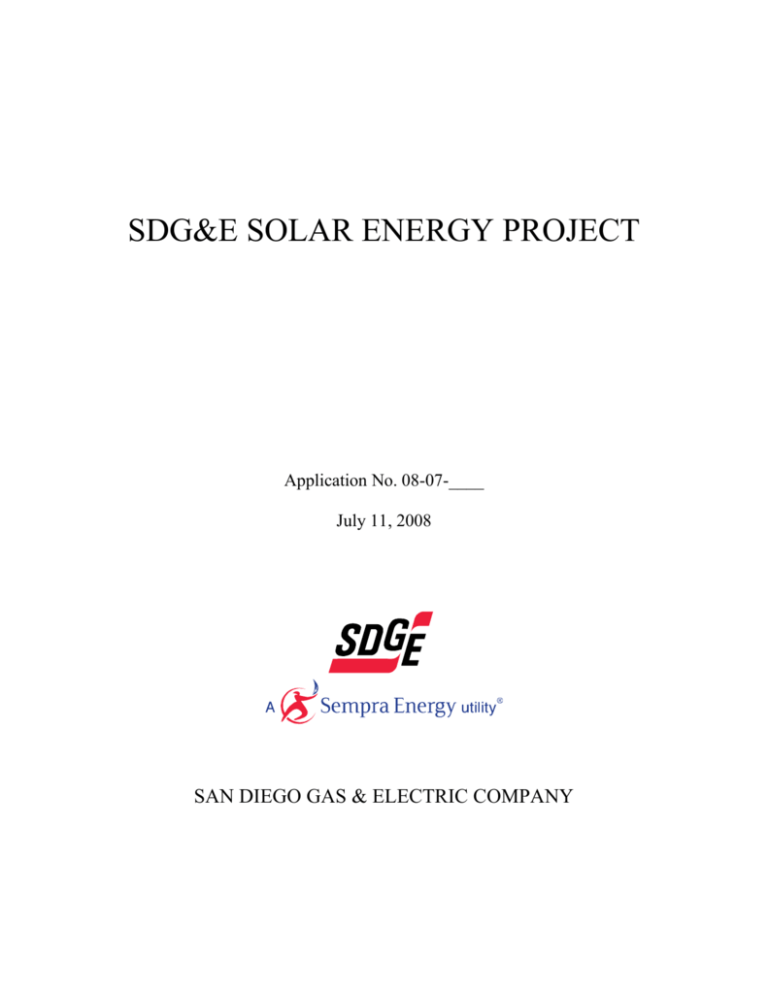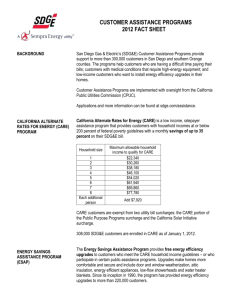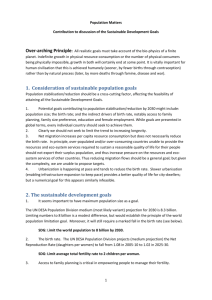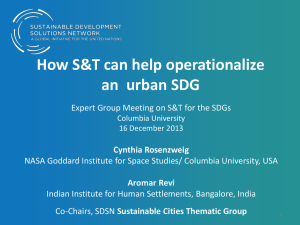SDG&E SOLAR ENERGY PROJECT
advertisement

SDG&E SOLAR ENERGY PROJECT Application No. 08-07-____ July 11, 2008 SAN DIEGO GAS & ELECTRIC COMPANY SDG&E SOLAR ENERGY PROJECT The following serves as the prepared direct testimony of San Diego Gas & Electric Company (“SDG&E”) in support of its application to the California Public Utilities Commission for the SDG&E Solar Energy Project. CHAPTER I – POLICY This chapter provides an overview of existing State policy goals and how the SDG&E Solar Energy Project supports these policy goals. The witness sponsoring this chapter is James P. Avery. CHAPTER II – DETAILED DESCRIPTION This chapter provides a detailed description of the SDG&E Solar Energy Project including the need for the SDG&E Solar Energy Project, the objectives and benefits of the SDG&E Solar Energy Project, how the proposed SDG&E program provides unique benefits within the SDG&E service territory and resource requirements, and costs of the SDG&E Solar Energy Project. The witnesses sponsoring this chapter are Frank W. Thomas and Thomas O. Bialek. CHAPTER III – ILLUSTRATIVE REVENUE REQUIREMENT This chapter provides an illustrative revenue requirement which reflects the aggregate impact of the SDG&E Solar Energy Project fully implemented and describes the assumptions that are the basis for the calculations. The witness sponsoring this chapter is Christopher F. Yunker. CHAPTER IV – COST RECOVERY This chapter outlines the proposal for the cost recovery of the various activities described in Chapters II and III including SDG&E’s proposed regulatory framework for Commission approval of each individual solar project prior to construction. The witness sponsoring this chapter is Michelle A. Somerville. II SDG&E SOLAR ENERGY PROJECT EXECUTIVE SUMMARY Consistent with and in furtherance of State policy, and addressing a particular part of the solar photovoltaic (“PV”) market that to this point has been underdeveloped, San Diego Gas & Electric Company (“SDG&E”) seeks California Public Utilities Commission (“CPUC” or “Commission”) approval to implement its SDG&E Solar Energy Project. SDG&E expects that this proposal will result in up to 77 MWdc of new installed solar capacity in the San Diego load basin. Roughly two-thirds will be built, owned and operated by SDG&E and one-third will be owned by host customers or independent third parties. For SDG&E’s portion of the project, SDG&E proposes to build, own and operate up to 521 megawatts direct current (“MWdc”) of distributionconnected solar PV generating facilities in SDG&E’s load basin with a spending cap of $250 million over a five year period. SDG&E further expects that the opportunities the SDG&E Solar Energy Project will create for customers to co-construct solar PV facilities with SDG&E under this proposal may result in the installation of up to an additional 25 MWdc of capacity under the California Solar Initiative (“CSI”) that would not have otherwise been built. 1 The direct current capacity reporting basis is frequently utilized in the PV industry to report PV system output. If capacity is expressed on an alternating current (ac) basis the dc to ac conversion will be based on the CEC conversion of 1watt (dc) = 0.67 watt (ac) detailed as follows: A Guide to Photovoltaic (PV) System Design and Installation, CEC 2001, pg. 8-9 DC to AC inverter conversion: .90 Production tolerance derate: .95 Temperature derate: .89 Dirt & dust derate: .93 Mismatch & wiring derate: .95 Total (product): .67 Using this conversion factor, 52 MWdc equates to approximately 35 MWac. III SDG&E proposes that its portion of the SDG&E Solar Energy Project consist of multiple individual installations of solar PV generating facilities each in the 1 - 2 MWac2 size range. For each individual installation, SDG&E proposes to file a Tier 3 Advice Letter containing the details of the installation and seeking approval for cost recovery associated with that installation. SDG&E plans to utilize tracking technology that will maximize PV system output coincident with the predicted SDG&E system peak. SDG&E proposes to partner with hosts offering sites with open areas and parking lots, such as shopping malls and local governments, and with solar industry vendors and installers. The open areas and parking lots of the host partners offer particular advantages in that they are located close to SDG&E’s load areas and are in close proximity to locations where SDG&E’s distribution system can accommodate systems of 1 – 2 MWac in size. SDG&E also proposes to issue a competitive solicitation for the equipment and installation of the systems. If approved, the SDG&E Solar Energy Project will: Promote the development of multiple commercial PV projects with the participation of SDG&E, third party developers and customers supporting the development of a PV market segment (installations between 1 and 2 MWac), that is not currently being served through either utility or private investments; and Deploy tens of megawatts of solar tracking technology to maximize power production of a PV system during the SDG&E system peak and 2 While 1-2 MWac is the primary target range, installations could be larger depending on specific site conditions. IV thereby substantially enhancing the value of the installations to serve peak demand. A key benefit of the SDG&E Solar Energy Project will be the ability to increase amounts of PV capacity coincident with the SDG&E annual peak demand. Under conventional solar rooftop initiatives, as much as 50% of the name plate capacity of the solar arrays is lost at the time of system peak, which significantly reduces the on-peak benefits delivered by such installations. Throughout the state of California, different utilities face different challenges. In the San Diego region, SDG&E is severely capacity constrained. For this reason, by designing solar PV installations to increase their capacity output at the time of system peak, the value of solar PV power can be increased significantly. The tracking technology SDG&E plans to utilize will increase a PV system power output coincident with the predicted SDG&E system peak, while also realizing additional annual energy production over what would have been produced by a conventional rooftop installation of similar size. Such a system can increase on-peak output by as much as 65% relative to a typical flat-panel rooftop installation while producing 40% more energy in the course of a year. Specifically, SDG&E seeks Commission approval to: Implement the SDG&E Solar Energy Project that would consist of investment in up to 52 MWdc of utility-owned solar PV generating facilities with a spending cap of $250 million over a five-year period. The proposed SDG&E Solar Energy Project consists of multiple individual installations of solar PV generating V facilities of approximately 1 to 2 MWac each from 2009 through 2013. SDG&E proposes to file Tier 3 Advice Letters for approval of cost recovery for individual PV generating facilities. Recover initial administrative and preliminary development costs of $214,000 in 2008 and of $1,662,000 per year beginning in 2009 through the Non-fuel Generation Balancing Account (“NGBA”); Recover capital-related and operations and maintenance (“O&M”) revenue requirements for completed SDG&E Solar Energy Project installations through the NGBA; Create a new balancing account, the Solar Energy Project Balancing Account (“SEPBA”), to balance the authorized revenue requirement for administrative and preliminary development costs as requested in this application and authorized revenue requirement for each SDG&E Solar Energy Project facility with the actual capital-related revenue requirement and O&M expenses; and File a Tier 3 Advice Letter for Commission approval to construct each solar generation asset and for recovery of the capital-related and O&M revenue requirements associated with construction of that asset through the NGBA. VI






